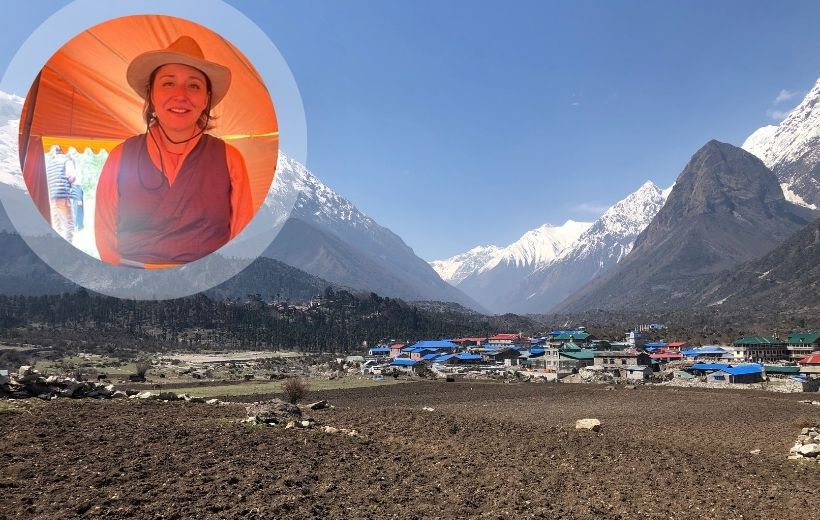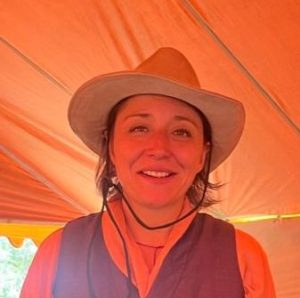Climate Response: Nurseries of Seedlings in the Himalayas
By Margot Clavier• 3 min read
By Margot Clavier• 3 min read

IMAGINE A VILLAGE located at an altitude of 3550m, four days’ walk from the nearest road in Northern Nepal. The community consists of farmers and semi-nomadic yak herders who raise their herds above the village during the summer months. The village has about 500 residents who are primarily Tibetan and practice Buddhism. It gets so cold in winter that many villagers are forced to go down to Kathmandu.
My name is Margot, and Mingyur Rinpoche hired me to work with the Himalayan Environment and Life Protection (H.E.L.P) NGO in his native village of Samagaun, which is located in the Nubri region. We carry out projects in agroecology, environmental protection, climate change adaptation and mitigation, and empowerment of communities, women, children, and men.
I am French, born and raised in an urban environment in Paris until I was 30. I had never heard the terms “passive solar greenhouse” or “agro-biodiversity” before arriving in Samagaun in 2019. I wouldn’t say I had never seen a tree — I had encountered them during my vacations in southern France — but their relevance to world development wasn’t obvious to me.
After Mingyur Rinpoche hired me in 2019, I first trekked throughout the Nubri region and settled in Samagaun to assess the needs of the communities — interviewing women, men, and children and taking an interest in animals dependent on humans.
Responding to the desires expressed during my interviews, we established a literacy course that integrated hygiene, nutrition, and income-generating activities through play. This course included English and math classes, as well as Nepali.
Gradually, I began living a life much closer to nature than I had ever experienced. I observed the planting, growth, and harvesting of potatoes and barley. I stayed in the camps where nomads take the yaks to graze above the village (at 5000m) during the monsoon from June to September and tasted the yogurt and churpii (non-fermented cheese from yaks) made by the herders. I also observed the village emptying its inhabitants in May through June to harvest yarsagumba, the caterpillar fungus that grows on the high plateaus. The fungus has been a source of income for about fifteen years, selling at the price of gold in Shanghai’s wet markets.
In parallel, from the needs assessment and during my stay in the village since 2021, I have lived a life with minimal comfort: no running water, shower, or heating. I have to send voice messages from my phone — the internet arrived in 2022 — because it’s too cold in November (-11°C at night) to take my hands out from under my blanket to type text messages.
I had access to a limited number of foods but was unable to obtain basic supplies due to the village’s isolation. It’s a four-day walk to reach the nearest road, and everything is transported by mule — don’t forget your toothbrush! I realized that food security was a fundamental element of a community’s survival: Samagaun’s inhabitants grow barley and potatoes for only three months of the year because of the cold, and vegetables are imported, which is very expensive.
So I began working to implement a bioclimatic greenhouse project with stone walls and a roof made with a double layer of polycarbonate, allowing villagers — prioritizing the poorest women — to grow tomatoes, lettuce, cabbages, zucchini, beans, cucumbers, spinach, and chili peppers.
“Starting in May 2025, we will begin planting an additional 20,000 trees in the second nursery.” — Margot Clavier
July 2022 was like a thunderclap: at the beginning of the monsoon in early July, we were awakened in the middle of the night by a landslide caused by three days of torrential rain that buried a fifth of the fields, making agriculture impossible. According to Meme Gyamtso, the oldest lama in the village, such a phenomenon had never occurred in Samagaun in 90 years. I then became aware that Nubri was heavily affected by climate change and that greenhouse gas emissions produced, among others, by the West were directly impacting the survival of Samagaun villagers.
If I wanted to honor my responsibility toward nature, I needed to reforest to mitigate the effects of climate change. This would help absorb CO2 from the atmosphere, reduce landslides, and allow the community to have firewood and construction wood while fighting global warming in the Himalayas and worldwide.
So, I started the community reforestation project in Samdo, the village above Samagaun located at 3900m altitude, in November 2022 to plant local tree species and restore and regenerate the forests and ecosystems of the region. The project has been successful, driven by the strength and work of the community and the H.E.L.P. team. We currently have 20,000 pines, birches, junipers, poplars, and willows growing at 4000m altitude in the Himalayas in the nursery we built.
The villagers could now grow cabbages, cauliflowers, and lettuces outside their homes, which was impossible before due to the cold. As climate change accelerated, we needed to outpace it if we wanted to have a chance of having an effect against it. So, together with the community forestry group and the Samdo community, we decided to build a second nursery to plant 20,000 more trees each year for mass reforestation. Starting in May 2025, we will begin planting an additional 20,000 trees in the second nursery, which is currently under construction.
Together, we can take beneficial action for the environment and our communities. We can honor our responsibility towards nature, protect it, and give back what it gives us — all driven by the inspiration and blessings of Mingyur Rinpoche.
Help us accomplish this project by planting one, two, or three trees or perhaps even a forest!
April 2025

Learn meditation under the skillful guidance of world-renowned teacher Yongey Mingyur Rinpoche at your own pace.


Janet Ritvo has been the backbone of Tergar Canada, its longest serving director, taking on the role of secretary and then president. She has tended to Tergar Canada as a mother would a child — with great care and perseverance, providing stability to the ups and downs that organizations commonly go through.

“I could see how the people at the hospice have challenges, just like others, and they don’t have access to meditation.” – Stefan Markov

When her mind wouldn’t stop spinning and her heart was breaking, Liliana Maravilla found a pathway to her true home.
If you enjoyed reading our articles, please join our mailing list and we’ll send you our news and latest pieces.